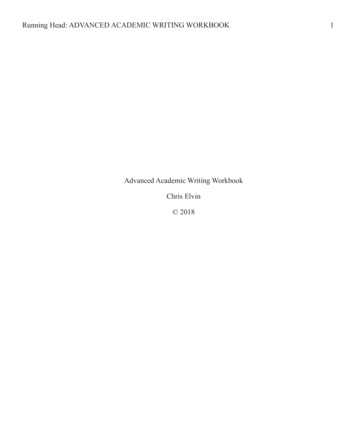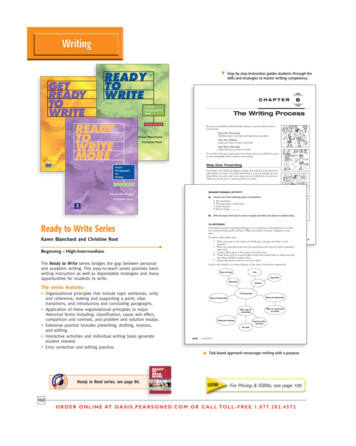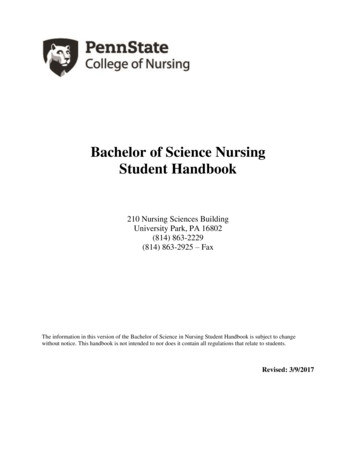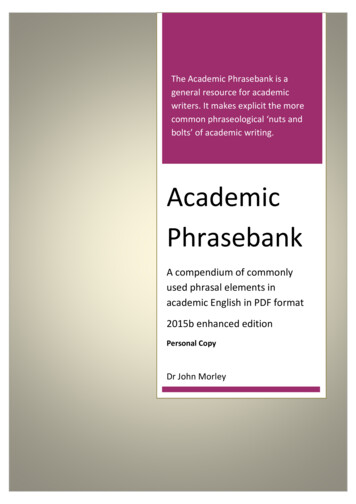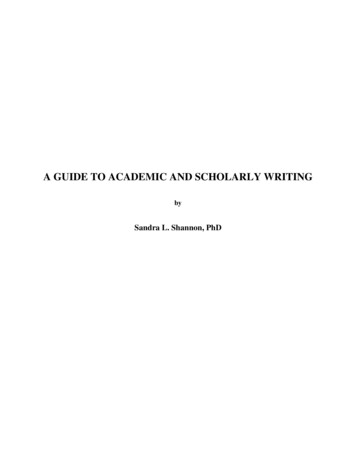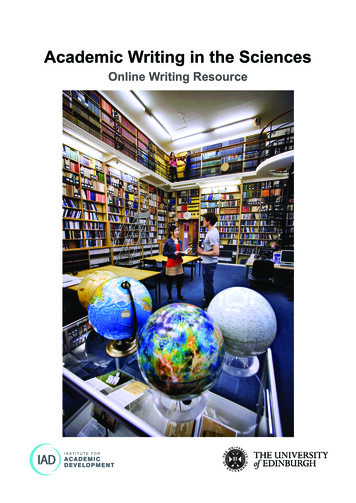
Transcription
Academic Writing in the SciencesOnline Writing Resource Universi-
Academic Writing in the SciencesPublishing is a crucial part of doing research. Yet, many students and other inexperienced writersoften struggle with learning the skills required for good academic writing, while their supervisorsor other experienced academics often lack the time to provide much needed guidance. As aresult, students frequently lament a sense of overwhelming and anxiety that hinders theirprogress and prevents them from approaching writing with confidence and ease.The term academic writing refers to a specific form of prose used in an academic context for anumber of different purposes, such as fulfilling the requirements of a PhD exam through thesubmission of a PhD thesis or sharing and advancing knowledge through the publication ofresearch papers.Unlike other forms of academic writing, however, scientific writing follows a well-defined structurethat other scholars can easily recognise and identify. So, in some respect, scientific writing iseasier that other academic prose. Scientific writing also differs from academic writing in otherdisciplines for some defining features. These are reflected in a language that is accurate,specific, concise, clear, cautious, and objective [1].Learning about the structure and style of scientific writing can (and should!) be achieved at thereading stage. Once you start paying attention to the structure and style of the papers you read(rather than just focusing on their content) you may realise that most scientific papers are thesame! Emulating their key features will help you produce good drafts in your own writing. University of Edinburghwww.ed.ac.uk/iad
Academic Writing in the SciencesThe structure of a scientific paper, thesis or dissertationResearch papers (but also PhD theses and dissertations) in scientific subjects typically containthe following sections (generally in the order shown below):AbstractThis is the most read part of any paper and in some case the only one fully accessible throughonline repositories. For papers that target a non-specialised audience, the abstract offers anoverview of the entire paper and contains information on the purpose of the study, the approachused, the key results obtained and possibly their implications in a given field. In such cases, theabstract is a bit like a paper in miniature. For papers that target a specialised audience, theabstract will normally contain only the methods and results obtained in the study.IntroductionThe main purpose of the introduction is to identify a problem or gap in current research and toprovide the motivation for the study. This is done by briefly recalling key results already availablein the literature and showing how/why any discrepancies or gaps hinder further progress. Theresearch gap identified in the introduction will then form the focus of the study presented in thepaper. Occasionally, the introduction may end with a brief overview of what can be found in thepaper and where.Literature ReviewWhether a paper contains a literature review section in its own right or not normally depends onthe type of paper. Regular Articles may contain such a section (sometimes called ScientificBackground or Current Status), but Letters do not. By contrast, Review Articles containextensive literature reviews and serve as an excellent starting point for students new to a givenresearch field. PhD theses normally have a whole chapter devoted to an in-depth review ofexisting literature around the specific project presented in the thesis.MethodsThe Methods section forms a key component of any scientific paper as it serves to provide allnecessary and sufficient information to allow interested readers to repeat the study if they sowish. Reproducibility of results is in fact at the heart of the scientific method (as formulated by thefounding figures of modern-day science such as Copernicus, Galilei and Bacon) and requiresthat the approach used in the study be fit for purpose. If it is not, the validity of the study (and theresults obtained) may be either questioned or completely invalidated.www.ed.ac.uk/iad
Academic Writing in the SciencesThe structure of a scientific paper, thesis or dissertationData Analysis and ResultsAs the name suggests, this section provides a description of the approach used to analyse thedata obtained in the study and offers an overview of the main results, often displayed in Figuresor summarised in Tables. Even though scientific writing is supposed to be objective, it isimportant that you tell your reader what you think of your results by using appropriate language(for example, by saying “in as many as 30% of cases” you may indicate that you regard yourresult as a strong one).Discussion and ConclusionFinally, the discussion and conclusion section (or sections) serve to compare your results tothose already available in the literature (discussion) and to present the implications of yourresults in the wider context of yourresearch field (conclusion).Even though most students are familiarwith the overall structure describedabove, few are aware that each ofthose sections has its own intrinsicstructure too. To discover what thisstructure is, you need to pay attentionto the function of each sentence orparagraph in the section. HilaryGlasman-Deal brilliantly explains howto do so in her excellent book ScienceResearch Writing for Non-NativeSpeakers of English [2]. She alsoprovides section templates that you canuse in your own writing. University of Edinburghwww.ed.ac.uk/iad
Academic Writing in the SciencesThe Five Steps of WritingKnowing how to structure your writing, however, is often not enough to help you avoid procrastination.Ultimately, the thought of summarising the results of years of research into a cohesive andcomprehensive PhD thesis or research paper can be a daunting prospect for most. For this reason, itmay be helpful to approach your writing as a sequence of specific steps, each devoted to fulfillingspecific tasks. The following steps provide a useful framework to organise your writing.Pre-writingThe purpose of this step is to learn about basic aspects of academic writing (content, structure andstyle) already at the reading stage. Paying attention to the structure as well as style can help youprepare templates to follow when planning to write specific sections.DraftingTo avoid the infamous writer’s block and facilitate your writing, you may start by talking about yourresearch (for example by giving a seminar in your department). You can then prepare the overall layoutof your paper (or thesis) by using mind maps or similar techniques. Once you are ready to write, aim forproducing relatively large amounts of content over a short period of time. Do not worry too much at thisstage about structure, grammar or punctuation. The text you produce here is simply meant as an earlydraft that you can revise and edit iteratively in the following steps until you produce a polished finalversion.RevisingThis is where you should start to pay specific attention to the overall structure of your early drafts andmake sure that the information is presented in a logical flow. When revising your text, make sure youidentify the most pressing issues and treat those in order of severity before focusing on minor, or lesspressing, details. Asking for feedback at this stage is one of the best ways to improve your writing.EditingEditing is when writing meets elegance. This is the stage where you need to improve your writing styleby carefully paying attention to the choice of words and the usage of language. For a bit of fun, checkhow well your writing scores in The Writer’s Diet Test [3]. Tips for improved style include using activeverbs, avoiding negatives, and de-cluttering your prose by removing empty words that do not addcontent to your text.ProofreadingThe purpose of this step is to make sure that the final work looks professional and error-free. Things tolook out for include checking for punctuation and grammar mistakes, formatting conventions, propercitations and bibliographic details. Figures and Tables should also conform to the high-quality standardsrequired for publication. Also, remember that Figures captions and Tables titles must provide enoughinformation for the readers to understand what is displayed without having to read the entire paper.www.ed.ac.uk/iad
Academic Writing in the SciencesReferences[1] M Aliotta (2018) Mastering Academic Writing in the Sciences: A Step-by-Step Guide, Taylor &Francis, CRC Press[2] H Glasman-Deal (2010) Science Research Writing for Non-Native Speakers of English,Imperial College Press[3] H. Sword (2016) The Writer’s Diet, Chicago Guides to Writing, Editing and Publishing University of Edinburghwww.ed.ac.uk/iad
Academic Writing in the SciencesFurther ResourcesH Glasman-Deal: Science Research Writing for Non-Native Speakers of English, Imperial College Press(2010)A very clear and well-designed book that will take you step by step into the process of structuring thevarious sections or chapters of your research paper or thesis. Lots of useful tables with frequently usedphrases on academic writing.A. Greene: Writing Science in Plain English. The University of Chicago Press (2013)A little gem of a book! A must-read for students and staff who want to improve their writing by applyingsome simple and practical strategies. Plenty of examples (and ‘solutions’) for you to practice your skills.P. Goodson: Becoming an Academic Writer – 50 Exercises for Paced, Productive, and Powerful,Writing. SAGE Publishing Ltd (2013)If you are short of ideas on practical things you can do to improve your writing, here you’ll find plenty ofsuggestions and examples.H. Sword: The Writer’s Diet. Chicago Guides to Writing, Editing and Publishing (2016)I just love the analogy between writing and eating! If you take the Writer’s Diet Test, don’t get toodisappointed with the results It’s good fun to see at once where your writing is going wrong.A.M. Koerner: Guide to publishing a scientific paper. Routledge (2008)If you are new to publishing a research paper, this book will take you through every step in the processfrom choice of journal, to manuscript submission, to response to reviewers’ comments. Excellent adviceeven if you are not new to publishing!W. Strunk: Elements of Style. Dover Publications Inc. (2006)A classic that never seems to go amiss. Some advice is probably out dated, but plenty is still valid todayas it was almost a hundred years ago, when the book first came out.I. Atkinson: Copy. Righter. LID Publishing Ltd (2011)Not exactly a book on academic writing. But there is nothing wrong about borrowing some of the besttactics that highly successful copywriters use to hook their readers!This resource was created by Marialuisa Aliotta, Professor of Experimental Nuclear Astrophysics at theUniversity of Edinburgh (UK). Marialuisa runs popular writing workshops at various universities inScotland and overseas. More information on the type of support she offers to PhD students and earlycareer academics can be found at:https://academiclife.coachesconsole.com and http://www.handsonwriting.comMarialuisa is also the author of Mastering Academic Writing in the Sciences: A Step-by-Step Guide,published by Taylor & Francis Group, LLC. The book will become available in the UK from May 2018.This work is licensed under a CC BY-NC-ND licenceTo view a copy of this license, visit: www.ed.ac.uk/iad
Academic Writing in the Sciences Publishing is a crucial part of doing research. Yet, many students and other inexperienced writers often struggle with learning the skills required for good academic writing, while their supervisors or other experienced academics

